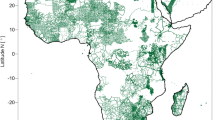Abstract
The gravity database for the IAG African Geoid Project contains significantly large data gaps. These large data gaps affect the interpolation precision of the reduced gravity anomalies needed for the determination of the gravimetric geoid for Africa. Our aim is to develop a suitable interpolation technique that can be used for a proper gravity interpolation within large data gaps. A gap of 10° × 5° in the latitude and longitude directions, respectively, located at the high lands of Ethiopia has been artificially created within the gravity data set for Africa. The rest of the data set has been used to interpolate the gravity values at the gap points; then a comparison between the interpolated and the actual data values at the artificial data gap has been carried-out to determine the accuracy of the used interpolation technique. The unequal weight least-squares prediction (with the optimum curvature parameter at the origin) with an underlying grid at the gap areas computed by the satellite-only GO CONS GCF 2 DIR R5 model till degree and order 300, has been proposed as the developed interpolation approach. For comparison purpose, the Kriging interpolation technique has also been tested. Both the classical residual terrain modeling reduction and the window technique, suggested earlier by the authors to get rid of the double consideration of the topographic-isostatic masses within the data window in the framework of the remove-restore technique, have been used for the reduction process. A comparison between the data and interpolated values of the gravity at the gap points has been carried out. The results show that the developed interpolation technique gives better interpolation accuracy at the artificial data gap.
Similar content being viewed by others
References
Abd-Elmotaal H.A., 1992. Statistical behaviour of the free-air, Bouguer and isostatic anomalies in Austria. Bull. Geod., 66, 325–335, DOI: https://doi.org/10.1007/BF00807417.
Abd-Elmotaal H.A., 1998, An alternative capable technique for the evaluation of geopotential from spherical harmonic expansions. Boll. Geod. Sci. Affin., 57, 25–38.
Abd-Elmotaal H.A., 2015. Validation of GOCE models in Africa. Newton’s Bull., 5, 149–162.
Abd-Elmotaal H.A. and Kühtreiber N., 1999. Improving the geoid accuracy by adapting the reference field. Phys. Chem. Earth, 24, 53–59, DOI: https://doi.org/10.1016/S1464-1895(98)00010-6.
Abd-Elmotaal H.A. and Kühtreiber N., 2003. Geoid determination using adapted reference field, seismic Moho depths and variable density contrast. J. Geodesy, 77, 77–85.
Abd-Elmotaal H.A. and Kühtreiber N., 2014a. Automated gross error detection technique applied to the gravity database of Africa. Geophys. Res. Abs., 16, EGU2014–92.
Abd-Elmotaal H.A. and Kühtreiber N., 2014b. The effect of DHM resolution in computing the topographic-isostatic harmonic coefficients within the window technique. Stud. Geophys. Geod., 58, 41–55, DOI: https://doi.org/10.1007/s11200-012-0231-6.
Abd-Elmotaal H.A. and Kühtreiber N., 2015. On the computation of the ultra-high harmonic coefficients of the topographic-isostatic masses within the data window. Geophys. Res. Abs., 17, EGU2015–355.
Abd-Elmotaal H.A. and Kühtreiber N., 2016. Effect of the curvature parameter on least-squares prediction within poor data coverage: Case study for Africa. Geophys. Res. Abs., 18, EGU2016–271.
Abd-Elmotaal H.A. and Makhloof A., 2013. Gross-errors detection in the shipborne gravity data set for Africa. Presented at Geodetic Week, Essen, Germany, October 8–10, 2013 (https://doi.org/www.geodaetische-woche.de/2013/session02/Abd-Elmotaal-Makhloof.pdf).
Abd-Elmotaal H.A., Makhloof A., Abd-Elbaky M. and Ashry M., 2017. The African 3″ × 3″ DTM and its validation. In: Vergos G.S., Pail R. and Barzaghi R. (Eds), International Symposium on Gravity, Geoid and Height Systems 2016. International Association of Geodesy Symposia 148, Springer, Cham, Switzerland, 79–86, DOI: https://doi.org/10.1007/1345_2017_19.
Abd-Elmotaal H.A., Seitz K., Kühtreiber N. and Heck B., 2015. Establishment of the gravity database AFRGDB V1.0 for the African geoid. In: Jin S. and Barzaghi R. (Eds), IGFS 2014. International Association of Geodesy Symposia 144, Springer, Cham, Switzerland, 131–138, DOI: https://doi.org/10.1007/1345_201551.
Bruinsma S.L., Förste C., Abrikosov O., Marty J.-C., Rio M.-H., Mulet S. and Bonvalot S., 2013. The new ESA satellite-only gravity field model via the direct approach. Geophys. Res. Lett., 40, 3607–3612, DOI: https://doi.org/10.1002/grl.50716.
Forsberg R., 1984. A Study of Terrain Reductions, Density Anomalies and Geophysical Inversion Methods in Gravity field Modelling. Report 355. Department of Geodetic Science and Surveying, Ohio State University, Columbus, OH.
Kraiger G., 1988. Influence of the curvature parameter on least-squares prediction. Manus. Geod., 13, 164–171.
Moritz H., 1976. Covariance Functions in Least-Squares Collocation. Report 240. Department of Geodetic Science and Surveying, Ohio State University, Columbus, OH.
Moritz H., 1980. Advanced Physical Geodesy. Wichmann, Karlsruhe, Germany.
Olea R.A., 1999. Geostatistics for Engineers and Earth Scientists. Kluwer Academic Publishers, Boston, MA, DOI: https://doi.org/10.1007/978-1-4615-5001-3.
Pavlis N.K., Holmes S.A., Kenyon S.C. and Factor J.K., 2012. The development and evaluation of the Earth Gravitational Model 2008 (EGM2008). J. Geophys. Res., 117, B04406, DOI: https://doi.org/10.1029/2011JB008916.
Acknowledgements
This project was supported financially by the Science and Technology Fund (STDF), Egypt, Grant No. 7944. The support by the International Association of Geodesy (IAG) and the International Union of Geodesy and Geophysics (IUGG) is kindly acknowledged. The authors would like to thank Dr. Sylvain Bonvalot, Director of the Bureau Gravimétrique International (BGI), for providing part of the used data set for Africa. The authors would like to thank Dr. Petr Holota (the editor of this paper) and the anonymous reviewers for their useful suggestions and critical comments.
Author information
Authors and Affiliations
Corresponding author
Rights and permissions
About this article
Cite this article
Abd-Elmotaal, H.A., Kühtreiber, N. Suitable gravity interpolation technique for large data gaps in Africa. Stud Geophys Geod 63, 418–435 (2019). https://doi.org/10.1007/s11200-017-0545-5
Received:
Revised:
Accepted:
Published:
Issue Date:
DOI: https://doi.org/10.1007/s11200-017-0545-5




